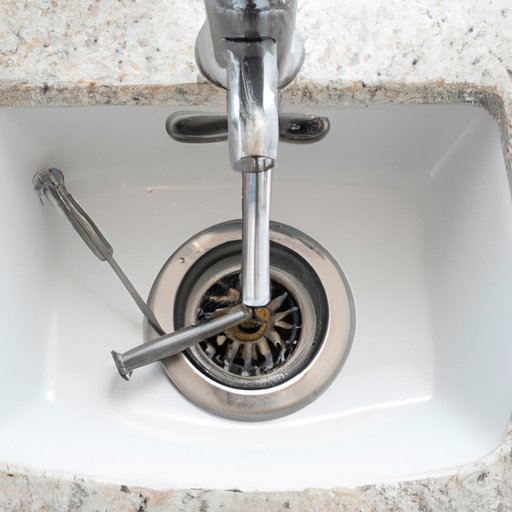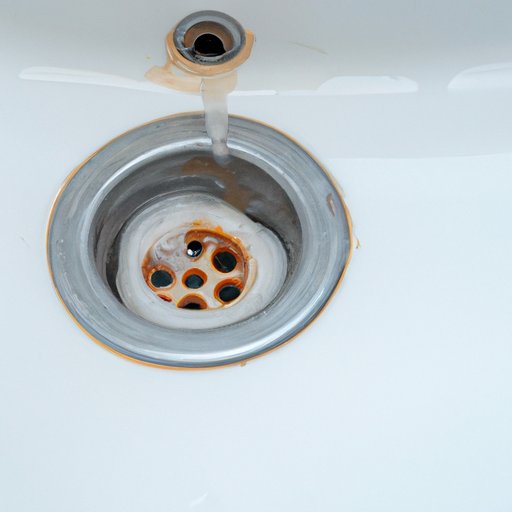Introduction
Dealing with a clogged bathroom sink can be frustrating. Not only does it prevent you from using the sink for its intended purposes, but it can also cause unpleasant odors and even water damage if left untreated. Fortunately, with the right tools and techniques, unclogging a bathroom sink can be a simple and manageable DIY task. In this article, we will explore the different methods for unclogging a bathroom sink, from using common household items to professional plumbing tools, as well as preventative measures to avoid future clogs.
5 Simple Steps to Unclog Your Bathroom Sink without Calling a Plumber
Before reaching for the phone to call a plumber, try these five simple steps to unclog your bathroom sink:
1. Clearing the blockage with hot water
One of the easiest and quickest ways to unclog a bathroom sink is by using hot water. First, remove any standing water from the sink. Next, boil a pot of water and carefully pour it down the drain in stages, giving the hot water a chance to work its way through the blockage. Let the hot water sit for a few minutes, and then turn on the faucet to see if the clog has been cleared.
2. Using a plunger to dislodge the clog
A plunger can also be an effective tool for clearing a bathroom sink clog. First, remove the sink stopper or drain cover. Next, place the plunger over the drain and create a tight seal around the rim of the sink. Gently pump the plunger up and down several times to create suction and dislodge the clog. Finally, turn on the faucet to see if the water is draining properly.
3. Removing the stopper and clearing the blockage manually
If the clog is visible, it may be possible to remove it manually. First, remove the sink stopper or drain cover. Then, use a pair of needle-nose pliers or a bent wire hanger to reach down into the drain and pull out any hair, grease, or other debris that may be causing the blockage. Once the blockage has been removed, reassemble the drain and test to see if the sink is draining properly.
4. Using a plumbing snake to remove tough clogs
If the clog is deep within the piping, a plumbing snake may be needed to remove it. First, remove the sink stopper or drain cover. Next, insert the snake into the drain and turn the handle to work the snake through the piping. Once the snake hits the obstruction, gently turn the handle to break up the clog. Finally, remove the snake and test to see if the sink is draining properly.
5. Flushing the drain with baking soda and vinegar to maintain cleanliness
Even if you have successfully removed the clog, it’s important to maintain the cleanliness of your drain to prevent future clogs from forming. One way to accomplish this is by using a baking soda and vinegar solution. First, pour one cup of baking soda down the drain, followed by one cup of white vinegar. Cover the drain with a drain plug or a wet rag to prevent the solution from escaping. Let the mixture sit for five minutes before flushing the drain with hot water.
DIY Guide: How to Unclog Your Bathroom Sink with Everyday Household Items
You don’t need to invest in expensive plumbing tools to effectively unclog a bathroom sink. Many common household items can be used to clear a sink blockage:
- Boiling water
- Baking soda and vinegar
- Salt and boiling water
- Borax and boiling water
- Coke or Pepsi
Here’s how to use these items to clear your bathroom sink:
- Boiling water: As previously mentioned, boiling water can be an effective method for clearing sink blockages. Follow the instructions outlined in step 1 above.
- Baking soda and vinegar: Follow the instructions outlined in step 5 above.
- Salt and boiling water: First, pour a half cup of salt down the drain. Next, pour in boiling water. The salt will dissolve and settle into the clog, and the hot water will help move it through the piping.
- Borax and boiling water: First, pour a half cup of borax down the drain. Then, pour in boiling water. The borax will settle into the clog and help dissolve it, while the hot water will move it through the piping.
- Coke or Pepsi: Pour a can of Coke or Pepsi down the drain and let it sit for an hour. The phosphoric acid in the soda can help dissolve the blockage. Rinse with hot water.

The Best Tools for Unclogging Your Bathroom Sink and How to Use Them
While many common household items can be used to unclog a bathroom sink, sometimes the blockage is too stubborn and requires specialized plumbing tools. Here are three of the best tools for unclogging a bathroom sink:
1. Plunger
The plunger is one of the most versatile plumbing tools and can be used to clear a variety of sink blockages. Follow the instructions outlined in step 2 above for using a plunger to clear a sink clog.
2. Plumbing snake
The plumbing snake is a long, flexible tool that can be inserted into the drain to break up and remove stubborn clogs. Follow the instructions outlined in step 4 above for using a plumbing snake to clear a sink clog.
3. Zip-it tool
The zip-it tool is a long, plastic, barbed tool that can be inserted into the drain to remove hair and other debris. To use the zip-it tool, insert it into the drain, rotate it, and pull it out. Discard any debris that is removed.
How to Prevent Bathroom Sink Clogs in the First Place: Tips and Tricks
While it’s impossible to completely prevent all bathroom sink clogs, there are several preventative measures you can take to minimize their occurrence:
- Use a drain stopper to catch hair and other debris
- Avoid pouring grease or oil down the drain
- Run hot water down the drain after each use to prevent buildup
- Periodically flush the drain with boiling water or baking soda and vinegar
- Regularly clean the sink stopper to prevent hair and other debris from accumulating
Green Solutions: Natural Ways to Unclog Your Bathroom Sink and Protect the Environment
In addition to being effective, many natural solutions for unclogging a bathroom sink are also environmentally friendly. Here are some natural methods you can try:
- Baking soda and vinegar
- Borax, salt, and vinegar
- Lemon juice and baking soda
- Hot water and dish soap
Dealing with Tough Clogs: Tips for Handling Persistent Bathroom Sink Blockages
Even with the best preventative measures, it’s still possible to encounter a stubborn clog from time to time. Here are some tips for handling persistent bathroom sink blockages:
- Don’t use chemical drain cleaners, as they can damage your pipes
- Try a combination of different methods, such as using a plunger followed by a plumbing snake
- Consider calling a professional plumber if the clog persists
When to Call a Professional: Identifying Serious Clogs and Knowing When It’s Time to Ask for Help
While many bathroom sink clogs can be handled with simple DIY methods, some clogs are more serious and require the expertise of a professional plumber. Here are some warning signs that indicate a serious clog:
- Multiple drains in the house are clogged
- There is no water in the toilet bowl
- There are unpleasant odors coming from the drain
- The water pressure in the sink has decreased significantly
If you notice any of these warning signs, it’s important to call a professional plumber to address the issue before it gets worse.
Conclusion
Dealing with a clogged bathroom sink can be a hassle, but with the right tools and techniques, you can remove the blockage and prevent future clogs from occurring. Remember to follow preventive measures, such as regular cleaning and avoiding pouring oil or grease down the drain. With a little elbow grease, you can keep your bathroom sink draining freely and avoid costly trips to the plumber.
